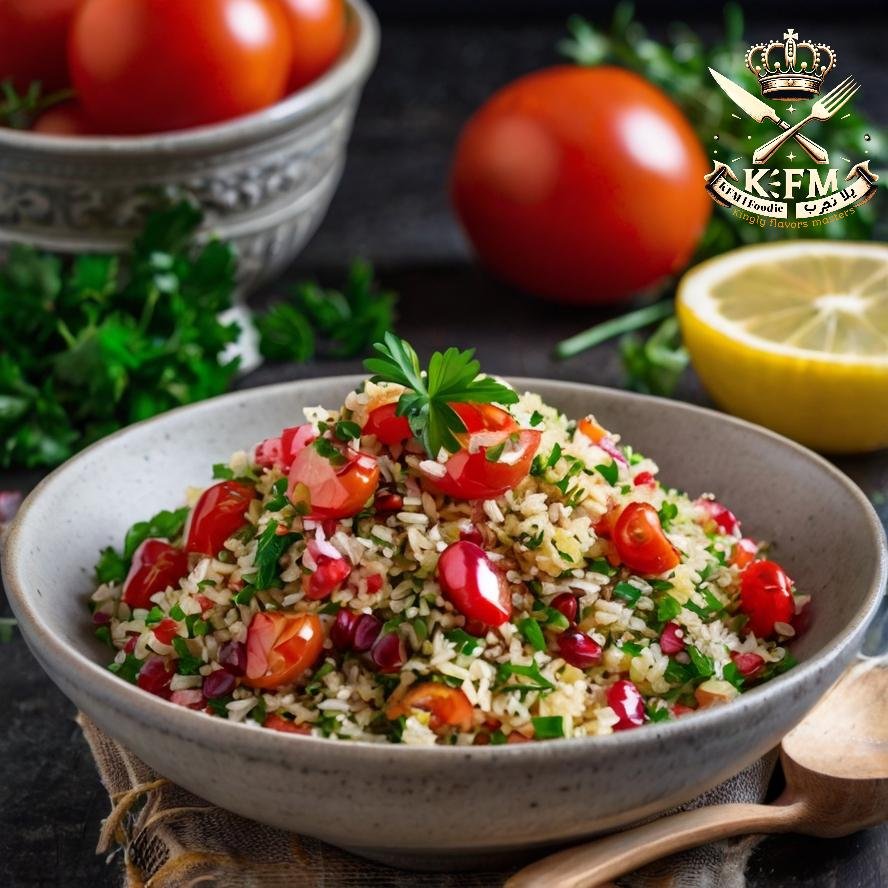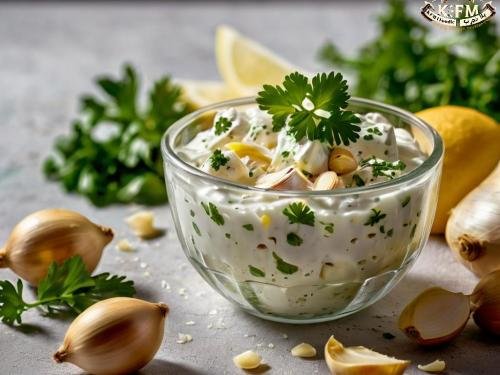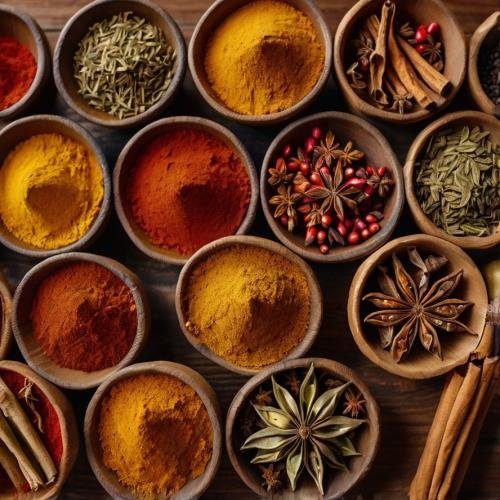Armenian Tabbouleh is one of the delicious dishes that combines diverse flavors, providing a unique culinary experience. Its preparation relies on rich ingredients such as bulgur, tomatoes, and onions, making it a light dish full of nutritious elements. This tabbouleh offers many health benefits due to its ingredients rich in vitamins and minerals, such as vitamin C found in tomatoes and parsley, and iron and magnesium in bulgur. Additionally, pomegranate molasses and cumin add a distinctive flavor and contribute to heart health and improved digestion. In this article, we will explore the detailed preparation of Armenian tabbouleh, highlighting its health benefits and any potential harm that may result from excessive consumption.

Ingredients for Armenian Tabbouleh:
- Bulgur: 1 cup of bulgur soaked in water for 15 minutes.
- Chopped Tomatoes: 1 ½ cups.
- Green Onions: 3 pieces, finely chopped.
- Tomato Paste: 3 tablespoons.
- Chopped Parsley: 1 tablespoon.
- Pomegranate Molasses: ¼ cup.
- Lemon Juice: 1 tablespoon.
- Cumin: 3 tablespoons.
- Salt: 1 teaspoon.
- Water: ¼ cup.
- Olive Oil: ¼ cup.
- Vegetable Oil: 1 tablespoon.
Explanation of Why Some Ingredients are Used:
- Pomegranate Molasses: It is one of the key ingredients that uniquely enhances the flavor of Armenian tabbouleh. In addition to giving the dish a slightly sour taste with a mild sweetness, it contains powerful antioxidants that support heart health and the immune system.
- Cumin: Not only does cumin add a warm, strong flavor, but it also has many health benefits, such as aiding digestion. Cumin contains antimicrobial properties and has anti-inflammatory effects.
Alternatives for Ingredients:
- If pomegranate molasses is not available, it can be replaced with lemon juice and honey to achieve a similar sweet and sour taste.
- Tomato paste can be substituted with fresh tomato sauce if you prefer the natural and refreshing taste of tomatoes.
- Cumin can be reduced if you don’t like the strong flavor of cumin.
Preparation Method:
- Sauté the onions: In a pot over medium heat, heat the vegetable oil until hot. Add the chopped green onions and sauté them well until they wilt and turn golden, which takes about 10 minutes. Make sure to stir the onions regularly to avoid burning.
- Add the bulgur: After draining the bulgur from the water, add it to the pot with the onions and stir well. This helps the bulgur absorb the onion flavors and enhances the taste.
- Mix the ingredients: Add the chopped tomatoes, tomato paste, and water to the mixture. Stir the ingredients together and let it simmer until the water evaporates, and the mixture becomes cohesive. This should take about 15 minutes.
- Seasoning: Once the water has evaporated, season the mixture with salt, cumin, and pomegranate molasses. Stir the ingredients well to ensure the spices are evenly distributed.
- Final touches: Turn off the heat and scoop the mixture into a serving dish. Add the chopped parsley, lemon juice, and olive oil. Gently mix the ingredients until they are well combined. Additional olive oil can be added if desired.
- Serving: Serve the Armenian tabbouleh cold as a side dish or appetizer. It can be served with fresh bread or as part of a main meal.
Additional Tips
- Choosing Bulgur: Make sure to use fine bulgur to achieve a light and delicious texture. Coarse bulgur can affect the final consistency of the dish.
- Flavor Balance: You may need to adjust the amount of spices to your personal taste. Don’t hesitate to add a little more pomegranate molasses or lemon juice to achieve your preferred flavor.
- Storing Tabbouleh: If you have leftovers, you can store them in the fridge for a few days. You may need to add a little extra olive oil and lemon juice before serving again.
Armenian Tabbouleh is a dish rich in flavors and nutrients, making it an excellent choice for a light meal or a flavorful addition to your daily meals. Try preparing it at home and enjoy its delicious and healthy taste. Bon Appétit!
Note: This recipe is suitable for those looking for a light and healthy meal full of flavor, but it may not be suitable for those with gluten sensitivity due to its bulgur content.
Serving Suggestions:
- Serve tabbouleh with toasted bread or crispy chips as a light and crunchy snack.
- It can be used as a filling for vegetarian sandwiches, offering a delicious mix of tomatoes and parsley.
- Garnish the dish with pomegranate seeds for a decorative touch and unique flavor. Pomegranate also enhances the nutritional value of the dish.
Frequently Asked Questions:
- What’s the difference between Armenian tabbouleh and traditional tabbouleh? Armenian tabbouleh differs from traditional Lebanese tabbouleh by including tomato paste and pomegranate molasses. Lebanese tabbouleh relies more on parsley and lemon juice and has a lighter flavor profile.
- Can bulgur be replaced with another ingredient? Yes, bulgur can be substituted with other ingredients like quinoa or ground rice for people with gluten sensitivities. Quinoa is an ideal choice as it is packed with essential nutrients.
- How can I make Armenian tabbouleh healthier? You can reduce the amount of oil or replace it with a lower-calorie option like extra virgin olive oil. It’s also a good idea to increase the amount of vegetables, such as adding more tomatoes and cucumbers, and reduce the salt for better nutritional value.
- Can Armenian tabbouleh be served with specific dishes? Yes, Armenian tabbouleh can be served with a variety of dishes like grilled meats and kebabs, or used as a side dish alongside traditional Eastern dishes such as hummus and baba ghanoush.
- How long can tabbouleh be stored in the fridge? Armenian tabbouleh can be stored in an airtight container in the fridge for up to 3 days. However, it's best enjoyed fresh for optimal taste and texture.

Calories and Nutritional Values:
Bulgur (1 cup)
Calories: 150
Protein: 5.6g
Carbs: 34g
Fat: 0.5g
Fiber: 8g
Chopped Tomatoes (1.5 cups)
Calories: 32
Protein: 1.6g
Carbs: 7g
Fat: 0.4g
Fiber: 2g
Green Onions (3 pieces)
Calories: 15
Protein: 0.5g
Carbs: 3.5g
Fat: 0g
Fiber: 1.2g
Tomato Paste (3 tbsp)
Calories: 39
Protein: 1.5g
Carbs: 8.7g
Fat: 0.2g
Fiber: 2.7g
Chopped Parsley (1 tbsp)
Calories: 1
Protein: 0.1g
Carbs: 0.2g
Fat: 0g
Fiber: 0.1g
Pomegranate Molasses (1/4 cup)
Calories: 150
Protein: 0g
Carbs: 37.5g
Fat: 0g
Fiber: 0g
Lemon Juice (1 tbsp)
Calories: 4
Protein: 0.1g
Carbs: 1.2g
Fat: 0g
Fiber: 0.1g
Cumin (3 tbsp)
Calories: 66
Protein: 3.3g
Carbs: 11.4g
Fat: 3.3g
Fiber: 2.7g
Salt (1 tsp)
Calories: 0
Protein: 0g
Carbs: 0g
Fat: 0g
Fiber: 0g
Water (1/4 cup)
Calories: 0
Protein: 0g
Carbs: 0g
Fat: 0g
Fiber: 0g
Olive Oil (1/4 cup)
Calories: 477
Protein: 0g
Carbs: 0g
Fat: 54g
Fiber: 0g
Vegetable Oil (1 tbsp)
Calories: 120
Protein: 0g
Carbs: 0g
Fat: 13.6g
Fiber: 0g
Total Nutritional Values:
Calories: 1054
Protein: 12.7g
Carbs: 103.5g
Fat: 72g
Fiber: 16.8g
Nutritional Values and Their Impact on Health:
Bulgur: Contains a high amount of fiber that improves digestion and helps regulate blood sugar levels. It is also a good source of vitamins and minerals like iron and magnesium.
Pomegranate Molasses: Contains strong antioxidants like polyphenols that support heart health and fight inflammation. It may also improve skin and hair health.
Cumin: Helps improve digestion and reduce bloating. It has antimicrobial properties that enhance gut health.
These values are approximate and depend on the size of the ingredients used and the method of preparation. Nutritional values may vary slightly based on personal adjustments and additions.




















